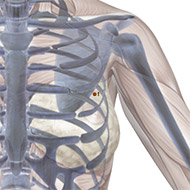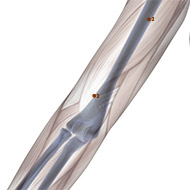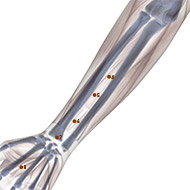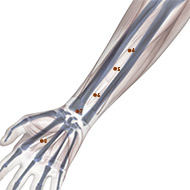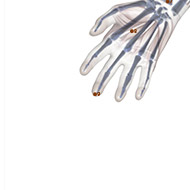The meridian system (simplified Chinese: 经络; traditional Chinese: 經絡; pinyin: jīngluò, also called channel network) is a concept in Traditional Chinese medicine (TCM) about a path through which the life-energy known as “qi” flows.1 The twelve standard meridians, also called principal meridians, are divided into Yin and Yang groups. The Yin meridians of the arm are Lung, Heart, and Pericardium. The Yang meridians of the arm are Large Intestine, Small Intestine, and Triple Burner. The Yin Meridians of the leg are Spleen, Kidney, and Liver. The Yang meridians of the leg are Stomach, Bladder, and Gall Bladder.2 The Pericardium Meridian or Pericardium Channel is one of the 12 principal meridians in TCM. It corresponds with the Shaoyang Sanjiao Meridian of the Hand. The. The Flow Hours of this meridian are 7:00 PM – 9:00 PM.3
CONTENTS
ORGAN AND FUNCTION
ACUPOINTS
FLOWING ROUTES
ORGAN AND FUNCTION
As distinct from the Western medical concept of pericardium, this concept from Traditional Chinese Medicine is more a way of describing a set of interrelated parts than an anatomical organ.4 The Pericardium is also called the “heart protector,” and, for clinical purposes, is considered a yin organ paired with the yang organ San Jiao. In general theory, the Pericardium is not distinguished from the Heart. It is also the first line of defense against the Heart from External Pathogenic Influences.5 The Pericardium has a meridian named for it, which reflects the health of the organ. In terms of the Five Elements, these organs are both associated with the fire element. In treatment, it is often best to approach heart problems via the Pericardium, rather than directly. The peak time for the Pericardium is from 7 pm to 9 pm.6
ACUPOINTS
This meridian contains 9 acupoints in one side, that is 18 acupoints in total.
PC-1
Location: In the fourth intercostal space, 1 cun lateral to the nipple and 5 cun lateral to the anterior midline.
Indications: Suffocating sensation in the chest, pain in the hypochondriac region, swelling and pain of the axillary regIon.
Acupuncture Method: Puncture obliquely 0.2-0.4 inch. Deep puncture is not advisable.
Moxibustion is applicable.
Vasculature: The thoracoepigastric vein, the branches of the lateral thoracic artery and vein.
Innervation: The muscular branch of the anterior thoracic nerve, the fourth intercostal nerve
PC-2
Location: 2 cun below the level of the anterior axillary fold, between the two heads of m. biceps brachii.
Indications: Cardiac pain, distension of the hypochondriac region, cough, pain in the chest, back and the medial aspect of the arm.
Acupuncture Method: Puncture perpendicularly 0.5-0.7 inch. Moxibustion is applicable.
Vasculature: The muscular branches of the brachial artery and vein.
Innervation: The medial brachial cutaneous nerve and the musculocutaneous nerve.
PC-3
Location: On the transverse cubital crease, at the ulnar side of the tendon of m. biceps brachii.
Indications: Cardiac pain, palpitation, febrile diseases, irritability, stomachache, vomiting, pain in the elbow and arm, tremor of the hand and arm.
Acupuncture Method: Puncture perpendicularly 0.5-0.7 inch, or prick with a three-edged needle to cause bleeding. Moxibustion is applicable.
Vasculature: On the pathway of the brachial artery and vein.
Innervation: The median nerve.
PC-4
Location: 5 cun above the transverse crease of the wrist, on the line connecting Quze (PC-3) and Daling (PC-7), between the tendons of m. palmaris longus and m. flexor carpi radialis.
Indications: Cardiac pain, palpitation, epistaxis, hematemesis, haemoptysis chest pain, furuncle, epilepsy.
Acupuncture Method: Puncture perpendicularly 0.5-1.0 inch. Moxibustion is applicable.
Vasculature: The median artery and vein; deeper, the anterior interosseous artery and vein.
Innervation: The medial antebrachial cutaneous nerve; deeper, the median nerve; deepest, the anterior interosseous nerve.
PC-5
Location: 3 cun above the transverse crease of the wrist, between the tendons of m. palmaris longus and m. flexor carpi radialis.
Indications: Cardiac pain, palpitation, stomachache, vomiting, febrile diseases, irritability, malaria, mental disorders, epilepsy, swelling of the axilla, contracture of the elbow and arm.
Acupuncture Method: Puncture perpendicularly 0.5-1.0 inch. Moxibustion is applicable.
Vasculature: The median artery and vein; deeper, the anterior interosseous artery and vein.
Innervation: The medial and lateral antebrachial cutaneous nerves, the palmar cutaneous branch of the median nerve; deeper, the anterior interosseous nerve.
PC-6
Location: 2 cun above the transverse crease of the wrist, between the tendons of m. palmaris longus and m. flexor radialis.
Indications: Cardiac pain, palpitation, stuffy chest, pain in the hypochondriac region, stomachache, nausea, vomiting, hiccup, mental disorders epilepsy, insomnia, febrile diseases, irritability, malaria, contracture and pain of the elbow and arm.
Acupuncture Method: Puncture perpendicularly 0.5-0.8 inch. Moxibustion is applicable.
Regional anatomy: See Jianshi (PC-5).
PC-7
Location: In the middle of the transverse crease of the wrist, between the tendons of m. palmaris longus and m. flexor carpi radialis.
Indications: Cardiac pain, palpitation, stomachache, vomiting, mental disorders, epilepsy, stuffy chest, pain in the hypochondriac region, convulsion, insomnia, irritability, foul breath.
Acupuncture Method: Puncture perpendicularly 0.3-0.5 inch. Moxibustion is applicable.
Vasculature: The palmar arterial and venous network of the wrist.
Innervation: Deeper, the median nerve.
PC-8
Location: At the center of the palm, between the 2nd and 3rd metacarpal bones, but close to the latter, and in the part touching the tip of the middle finger when a fist is made.
Indications: Cardiac pain, mental disorder, epilepsy, gastritis, foul breath, fungus infection of the hand and foot, vomiting, nausea.
Acupuncture Method: Puncture perpendicularly 0.3-0.5 inch. Moxibustion is applicable.
Vasculature: The Common palmar digital artery.
Innervation: The second common palmar digital nerve of the median nerve.
PC-9
Location: In the centre of the tip of the middle finger.
Indications: Cardiac pain, palpitation, loss of consciousness, aphasia with stiffness and swelling of the tongue, febrile diseases, heat stroke, convulsion, feverish sensation in the palm.
Acupuncture Method: Puncture superficially 0.1 inch or prick with a three-edged needle to cause bleeding. Moxibustion is applicable.
Vasculature: The arterial and venous network formed by the palmar digital proprial artery and vein.
Innervation: The palmar digital proprial nerve of the median nerve.
FLOWING ROUTES
This meridian originates from the chest and pertains to the pericardium. Then, it descends through the diaphragm and successively links with the upper, middle and lower energizer. Its branch from the chest runs inside the chest, emerges from the costal region, and ascends to the subaxillary region from the point 3 cun below the axilla (Tianchi, PC-1). Then it runs along the medial line of the upper arm to the cubital fossa and passes through the wrist, entering the palm (Laogong, PC-8). Then, along the radial side of the middle finger, it comes out at its radial tip (Zhongchong, PC-9). Another branch from the palm runs along the ulnar side of the ring finger to its tip, where it connects with the shaoyang triple energizer meridian of the hand.7
Footnotes
- What Is Traditional Chinese Medicine – sciencebasedmedicine.org – 2012, https://sciencebasedmedicine.org/what-is-traditional-chinese-medicine/
- Advanced Pressure Point Fighting of Ryukyu Kempo – A Dillman Karate International Book – 1994, https://www.amazon.com/Advanced-Pressure-Point-Fighting-Ryukyu/dp/0963199633/
- Acupuncture points of the pericardium meridian of the hand – cnacupuncture.com – 2017, http://www.cnacupuncture.com/points-of-the-pericardium-meridian-of-hand-jueyin.html
- Chinese natural cures – Black Dog & Leventhal Publishing – 1994, https://www.abebooks.com/book-search/isbn/1579120563/
- The foundations of chinese medicine: a comprehensive text for acupuncturists and herbalists – Black Dog & Elsevier Churchill Livingstone – 2005, https://www.amazon.com/Foundations-Chinese-Medicine-Comprehensive-Acupuncturists/dp/0443074895
- Chinese acupuncture and moxibustion – Foreign Languages Press – 1987, https://www.amazon.com/Chinese-Acupuncture-Moxibustion-Seventeenth-Printing/dp/7119059947/ref=sr_1_1?s=books&ie=UTF8&qid=1493125663&sr=1-1
- Jueyin Pericardium Meridian of the Hand – tcmwiki.com – 2017, https://tcmwiki.com/wiki/jueyin-pericardium-meridian-of-hand
LU01
LU02
LU03
LU04
LU05
LU06
LU07
LU08
LU09
LU10
LU11
LI01
LI02
LI03
LI04
LI05
LI06
LI07
LI08
LI09
LI10
LI11
LI12
LI13
LI14
LI15
LI16
LI17
LI18
LI19
LI20
ST01
ST02
ST03
ST04
ST05
ST06
ST07
ST08
ST09
ST10
ST11
ST12
ST13
ST14
ST15
ST16
ST17
ST18
ST19
ST20
ST21
ST22
ST23
ST24
ST25
ST26
ST27
ST28
ST29
ST30
ST31
ST32
ST33
ST34
ST35
ST36
ST37
ST38
ST39
ST40
ST41
ST42
ST43
ST44
ST45
SP01
SP02
SP03
SP04
SP05
SP06
SP07
SP08
SP09
SP10
SP11
SP12
SP13
SP14
SP15
SP16
SP17
SP18
SP19
SP20
SP21
HT01
HT02
HT03
HT04
HT05
HT06
HT07
HT08
HT09
SI01
SI02
SI03
SI04
SI05
SI06
SI07
SI08
SI09
SI10
SI11
SI12
SI13
SI14
SI15
SI16
SI17
SI18
SI19
BL01
BL02
BL03
BL04
BL05
BL06
BL07
BL08
BL09
BL10
BL11
BL12
BL13
BL14
BL15
BL16
BL17
BL18
BL19
BL20
BL21
BL22
BL23
BL24
BL25
BL26
BL27
BL28
BL29
BL30
BL31
BL32
BL33
BL34
BL35
BL36
BL37
BL38
BL39
BL40
BL41
BL42
BL43
BL44
BL45
BL46
BL47
BL48
BL49
BL50
BL51
BL52
BL53
BL54
BL55
BL56
BL57
BL58
BL59
BL60
BL61
BL62
BL63
BL64
BL65
BL66
BL67
KD01
KD02
KD03
KD04
KD05
KD06
KD07
KD08
KD09
KD10
KD11
KD12
KD13
KD14
KD15
KD16
KD17
KD18
KD19
KD20
KD21
KD22
KD23
KD24
KD25
KD26
KD27
PC01
PC02
PC03
PC04
PC05
PC06
PC07
PC08
PC09
TB01
TB02
TB03
TB04
TB05
TB06
TB07
TB08
TB09
TB10
TB11
TB12
TB13
TB14
TB15
TB16
TB17
TB18
TB19
TB20
TB21
TB22
TB23
GB01
GB02
GB03
GB04
GB05
GB06
GB07
GB08
GB09
GB10
GB11
GB12
GB13
GB14
GB15
GB16
GB17
GB18
GB19
GB20
GB21
GB22
GB23
GB24
GB25
GB26
GB27
GB28
GB29
GB30
GB31
GB32
GB33
GB34
GB35
GB36
GB37
GB38
GB39
GB40
GB41
GB42
GB43
GB44
LV01
LV02
LV03
LV04
LV05
LV06
LV07
LV08
LV09
LV10
LV11
LV12
LV13
LV14
GV01
GV02
GV03
GV04
GV05
GV06
GV07
GV08
GV09
GV10
GV11
GV12
GV13
GV14
GV15
GV16
GV17
GV18
GV19
GV20
GV21
GV22
GV23
GV24
GV25
GV26
GV27
GV28
CV01
CV02
CV03
CV04
CV05
CV06
CV07
CV08
CV09
CV10
CV11
CV12
CV13
CV14
CV15
CV16
CV17
CV18
CV19
CV20
CV21
CV22
CV23
CV24



